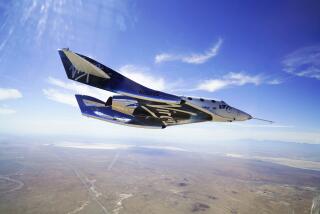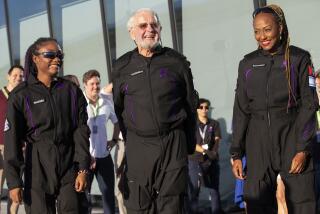With spaceships and airplanes under his belt, Richard Branson turns to submarines
- Share via
One of them owns a twin-engine airplane and a helicopter. The other? A fleet of spaceships.
Richard Branson, the billionaire adventurer, and Newport Beach real estate investor Chris Welsh unveiled a one-person submarine Tuesday that they said will be used to explore the deepest reaches of the world’s oceans.
The pair said they will begin later this year with the Mariana Trench, a 36,000-foot-deep valley that has not been visited by mankind since 1960, when a bulky, two-man submarine operated by the U.S. Navy made the voyage. At least two robot-controlled subs have made the trip since.
Although the U.S. government no longer has much interest in going to such depths, Welsh said he spent about $1 million of his own money on the project before catching the interest — and financial clout — of Branson, the founder of Virgin Atlantic Airways and Virgin Galactic.
“I can’t afford to get to the finish line on my own dollar,” Welsh said in February, when he was still looking for a backer.
Now, the costs for the expedition have been pegged at up to $17 million.
Predictably, perhaps, the 18-foot Deep Flight Challenger looks like something out of the Virgin fleet, a jet-like craft with short wings, a tapered nose and a cockpit.
Welsh and Branson met through their shared admiration of adventurer Steve Fossett, who was killed in 2007 when his plane crashed in the eastern Sierra Nevada. Through Fossett’s widow, both learned that before his death the explorer was planning a solo dive to the bottom of the Mariana Trench in a “flying” submarine.
“I must admit, I thought at first it was too dangerous,” Branson said after a news conference with Welsh at the Newport Harbor Yacht Club.
In the meantime, Welsh, who made his money buying and selling income properties, purchased the submarine and catamaran for less than $1 million and began assembling a team of scientists, engineers and filmmakers. He later approached Branson through a sports marketing agency.
Branson said he was impressed that Welsh appeared to have found a potential technological solution to the crushing pressure of the ocean’s depths — a quartz dome that should withstand 13 million pounds of pressure — so he joined the project.
“Chris saw the technology and a way forward,” Branson said. “He’s very entrepreneurial, and he’s fascinated by the science.... You need someone dedicated like him on an adventure like this.”
The submarine will sit atop the diesel-powered catamaran on voyages to exploration sites.
Chris Grech, deputy director of marine operations at the Monterey Bay Aquarium Research Institute, said the planned mission would be a remarkable journey because of the speed and maneuverability of the Virgin sub. The 1960 version, Grech said, “was basically a vertical elevator with people in it. It couldn’t move much. This thing is like an airplane underwater. It basically flies around … an amazing experience.”
One researcher involved in the project, University of Alaska Fairbanks geochemistry professor Geoff Wheat, said the craft’s mobility could allow it to take important video images of both the area’s geography and of jellyfish-like organisms that have either been little studied or never seen. Wheat said robot-powered submarines could end up traveling on missions to retrieve rock samples and specimens first spotted by Deep Flight Challenger.
Grech, however, cautioned that the scientific value of such a mission is currently unknown. The craft, he said, may find its greatest value in the way it helps satisfy the human need to push limits and explore.
“It’s sort of like ‘Why climb the tallest mountain?’ Because it is a big, big challenge, the great unknown, or because maybe it has not been attempted in years,” Grech said.
But before taking on the Mariana Trench, Welsh plans to practice in the calm waters off Newport Beach.
Branson said he intends to pilot at least one other dive — to the Puerto Rico Trench. After all, it’s the closest to his private island in the British Virgin Islands.
More to Read
Sign up for Essential California
The most important California stories and recommendations in your inbox every morning.
You may occasionally receive promotional content from the Los Angeles Times.











